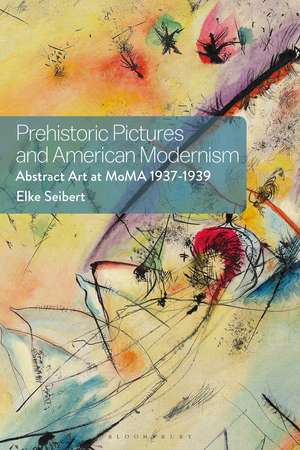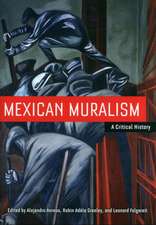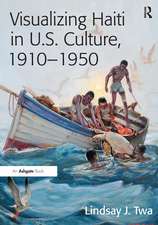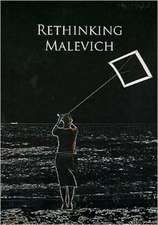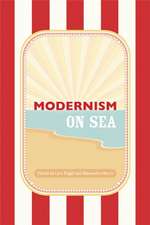Prehistoric Pictures and American Modernism: Abstract Art at MoMA 1937-1939
Autor Dr Elke Seiberten Limba Engleză Hardback – 18 oct 2023
Preț: 513.52 lei
Preț vechi: 733.02 lei
-30% Nou
Puncte Express: 770
Preț estimativ în valută:
98.27€ • 103.07$ • 81.80£
98.27€ • 103.07$ • 81.80£
Carte disponibilă
Livrare economică 11-25 martie
Preluare comenzi: 021 569.72.76
Specificații
ISBN-13: 9781350185241
ISBN-10: 1350185248
Pagini: 256
Ilustrații: 16 colour & 28 bw illus
Dimensiuni: 156 x 234 x 25 mm
Greutate: 0.68 kg
Editura: Bloomsbury Publishing
Colecția Bloomsbury Visual Arts
Locul publicării:London, United Kingdom
ISBN-10: 1350185248
Pagini: 256
Ilustrații: 16 colour & 28 bw illus
Dimensiuni: 156 x 234 x 25 mm
Greutate: 0.68 kg
Editura: Bloomsbury Publishing
Colecția Bloomsbury Visual Arts
Locul publicării:London, United Kingdom
Caracteristici
Makes source material publicly available, which is currently unavailable in digital form, and will continue to remain so for the foreseeable future
Notă biografică
Elke Seibert is a Post-Doctoral Research Fellow at the Cultural Department Canton Nidwalden, Switzerland, specialising in the interdisciplinary study of reception processes in contemporary and fine art from the 18th to the 20th century.
Cuprins
Part One: Introduction1 Preface2 Prehistory as a Modern Idea in Europe and "Primitivism" as intertwined concepts (1900-1940)Part Two: Prehistoric Artifacts, Prints, Painted Copies and the Genesis of Modern Art in New York (1937)3 Alfred Barr's View of Prehistory and Modernism as Shown at MoMA4 Barr`s exhibition concept: "Prehistoric" Avant-Garde and Lala Eve Rivol's Federal Art Project 5 Leo Frobenius's Objectives, His Collection in Western debates-and Henry Moore6 The Making of the MoMA Exhibition Prehistoric Rock Pictures in Europe and Africa (28 April-30 May, 1937) Part Three: The Art of Copying the Past-in Transatlantic Dialogue7 Copies and Copyists: Pictorial Heritage at the Museum of Modern Art8 Copying for the Index of American Design (1935-42) Part Four: Modern American Abstract Art and their Re-appropriation of Prehistoric Rock Paintings9 The Founding of the American Abstract Artists (1936) and their Appropriation of Prehistoric Rock Paintings (1937-40)10 Bridging Time and Space:Transcontinental AAA Networks in the Interwar Period 11 The Influence of (prehistoric) Artistic Concepts from Mexico on the American Abstract Artists12 Prehistorical Modernists: Gottlieb, Lassaw, Schanker, Smith Part Five: Conclusion13 The "Modernity" of Prehistory in the Thirties in Paris and New YorkAppendix I and IIBibliography Index
Recenzii
Opens a fascinating discourse on the undervalued artistic reception of prehistoric works in American 20th century art. This thoroughly researched book demonstrates not only the inspiration they had on modernist artists, but also how use of the controversial term "primitivism" was directly related to ethnographic and anthropological thought at the time.
Meticulously researched and strikingly ambitious in its aims and range, Elke Seibert's study is a highly original contribution to our understanding of American modernism. Drawing on largely neglected material from a rich variety of sources - from anthropological debates in 1930s New York to the activities of the American Abstract Artist group - this book explores with brilliance and in impressive detail the impact that an exhibition of prehistoric art made on artists in the 1930s, a phenomenon that until now has been largely overlooked.Apart from its importance for the history of modern art, this is an enthralling case study in the relationship between prehistoric and 20th century art that will resonate with any art historian concerned with issues of artistic influence and appropriation across history.
An illuminating journey into the nexus where prehistoric art, emerging modernism and discourses of the indigenous intertwined and generated a new understanding of what American art could be. A lucid testament to the power of art across time.
Meticulously researched and strikingly ambitious in its aims and range, Elke Seibert's study is a highly original contribution to our understanding of American modernism. Drawing on largely neglected material from a rich variety of sources - from anthropological debates in 1930s New York to the activities of the American Abstract Artist group - this book explores with brilliance and in impressive detail the impact that an exhibition of prehistoric art made on artists in the 1930s, a phenomenon that until now has been largely overlooked.Apart from its importance for the history of modern art, this is an enthralling case study in the relationship between prehistoric and 20th century art that will resonate with any art historian concerned with issues of artistic influence and appropriation across history.
An illuminating journey into the nexus where prehistoric art, emerging modernism and discourses of the indigenous intertwined and generated a new understanding of what American art could be. A lucid testament to the power of art across time.
